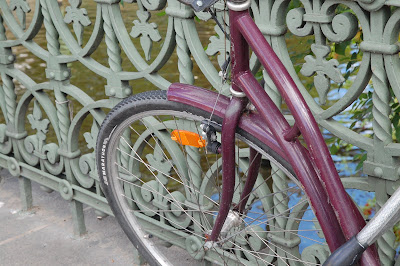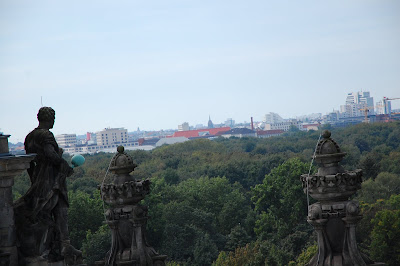 Three weeks ago, I was eating pastries on a daily basis and not due to stress eating, but for "cultural enrichment." Three weeks ago, I was embarrassing myself by trying to speak a language I barely knew, now I embarrass myself by speaking about poetry I barely understand in class. Three weeks ago, I got to have coffee with two of my closest friends and now we have to settle for virtual coffee over Facebook chat. Three weeks ago, I was in Berlin and I miss it.
Three weeks ago, I was eating pastries on a daily basis and not due to stress eating, but for "cultural enrichment." Three weeks ago, I was embarrassing myself by trying to speak a language I barely knew, now I embarrass myself by speaking about poetry I barely understand in class. Three weeks ago, I got to have coffee with two of my closest friends and now we have to settle for virtual coffee over Facebook chat. Three weeks ago, I was in Berlin and I miss it. I will always look back fondly at my time in Berlin. I've never had so much fun and felt so welcomed on any other "big European city vacation" that I've been on. You know, the one where the proportion of the maps exploding all over your hotel room is inverse to the rubber on the soles of your shoes as you traipse all over town. Normally, those vacations are a war of head over heels. My head tells me I need to appreciate every somber memorial and art museum even if it means I have to walk six miles to do so, but my heels tell me to sit down for a few minutes and enjoy another art form, a slice of torte. Inevitably, a strange compromise happens by the end of the trip: I can barely walk because I've climbed up the steps of every church I was supposed to see, but my waistline remains intact because of this, even if I probably ate more macaroons than Marie Antoinette. By the end, I'm utterly exhausted. However, when you visit two natives, they can tell you to skip the East Berlin museum, but see the East Side Gallery instead and they'll make sure you get your calories with the best strudel offered.
I will always look back fondly at my time in Berlin. I've never had so much fun and felt so welcomed on any other "big European city vacation" that I've been on. You know, the one where the proportion of the maps exploding all over your hotel room is inverse to the rubber on the soles of your shoes as you traipse all over town. Normally, those vacations are a war of head over heels. My head tells me I need to appreciate every somber memorial and art museum even if it means I have to walk six miles to do so, but my heels tell me to sit down for a few minutes and enjoy another art form, a slice of torte. Inevitably, a strange compromise happens by the end of the trip: I can barely walk because I've climbed up the steps of every church I was supposed to see, but my waistline remains intact because of this, even if I probably ate more macaroons than Marie Antoinette. By the end, I'm utterly exhausted. However, when you visit two natives, they can tell you to skip the East Berlin museum, but see the East Side Gallery instead and they'll make sure you get your calories with the best strudel offered.

However, it wasn't just having person tourguides in the form of my best friends that made Berlin so inclusive, but the city itself. Unlike a lot of the other major European cities I've visited where culture seems to have stopped in the 19th century or the 1920s and they are still capitalizing on the cafes where Hemingway threw back some wine and punches, Berlin is constantly generating culture. This is partially in efforts to reinvent a city whose legacy was mostly sordid in the past century and unite a community that was once forced to be divided. Regardless of the symbolism behind Berlin's barraging cultural scene, it's a lot of fun to be part of something as its happening.


These happenings can be highbrow as polemical art or as lowbrow as karaoke on a sunny Sunday afternoon in Mauer Park, but everyone can witness it and in most cases get involved. When you find yourself in one of these seemingly spontaneous creations of culture as a tourist, it's like finding the Holy Grail of traveling. You have stumbled upon something not to be found in the pages of guidebooks or recommended by the concierge, but something unique. Something that may only be occurring at this one point in time, a part of history even if it's just a street parade. You are not discovering a statue that was dug up centuries ago and sneezed on by a tourist from Phoenix just yesterday that you could've better seen on a postcard, you're discovering something that not even everyone in that city will know about. In can be summed up in this one little phrase, "only in Berlin." It's that rare moment where you feel like a local and sometimes cannot even be achieved when you're actually a local.


In Berlin, I experienced this magical moment multiple times. At the aforementioned karaoke in the park, which is such an "only in Berlin" event that tourists now flock to it. French tourists singing American pop songs may not seem like the most German experience, but at the end of the day, who cares who's singing, where else would they be singing other than Berlin?
 [The karaoke viewing crowd on a "lazy" Sunday.]
[The karaoke viewing crowd on a "lazy" Sunday.] [The karaoke is so popular that even this baby found a way to show off his moves.]
[The karaoke is so popular that even this baby found a way to show off his moves.]Another incident was sort of a meta historical moment. A once-in-a-lifetime street parade that was at the same time celebrating the 125th anniversary of the famous Ku'Daam Straße (or street.) We had only heard about it a few hours before, but it was was better than the Macy's Thanksgiving Day Parade with its mythical animal balloons. Even better yet, was the Japansese tourist who just walked right into the parade and no idea what was going on, boy, was he in for a magical moment.


Both Anneke and Caroline admit that Berlin can a bit isolating if you let it be. The universities are not centered on communal drinking (sorry, I mean societies) and are so literally far away from the city center that making friends is almost happenstance. Yet if you're willing to go and explore, you can find or make your own community.


I certainly want to make the effort to go back to Berlin as soon as possible. After convincing my parents that a plane ticket would be the best Christmas gift, I might find myself back in Germany a few months from now. Ideally, around Christmas given that Germans invented the holiday's better traditions.



 In the meantime, I must thank Anneke for being one of the most accommodating hostesses ever. She forsook her own bed and her thesis to make sure I was comfortable and had a good time. I wouldn't have enjoyed exploring Berlin half as much if I didn't get her helpful historical tidbits about every street corner. And I never would've been such a glutton if she hadn't helped me check various German vocab words so I could order food for myself. Caroline was equally a cultural and culinary enabler. Twelves hours of marathon eating wasn't nearly enough time to spend together. Both of you are welcome to my spare mattress back in Edinburgh.
In the meantime, I must thank Anneke for being one of the most accommodating hostesses ever. She forsook her own bed and her thesis to make sure I was comfortable and had a good time. I wouldn't have enjoyed exploring Berlin half as much if I didn't get her helpful historical tidbits about every street corner. And I never would've been such a glutton if she hadn't helped me check various German vocab words so I could order food for myself. Caroline was equally a cultural and culinary enabler. Twelves hours of marathon eating wasn't nearly enough time to spend together. Both of you are welcome to my spare mattress back in Edinburgh.
 Well, that's the end of this current batch of Berlin posts. I hope there are more in the future. Look forward to posts about the city I'm actually inhabiting right now soon enough!
Well, that's the end of this current batch of Berlin posts. I hope there are more in the future. Look forward to posts about the city I'm actually inhabiting right now soon enough!
















































